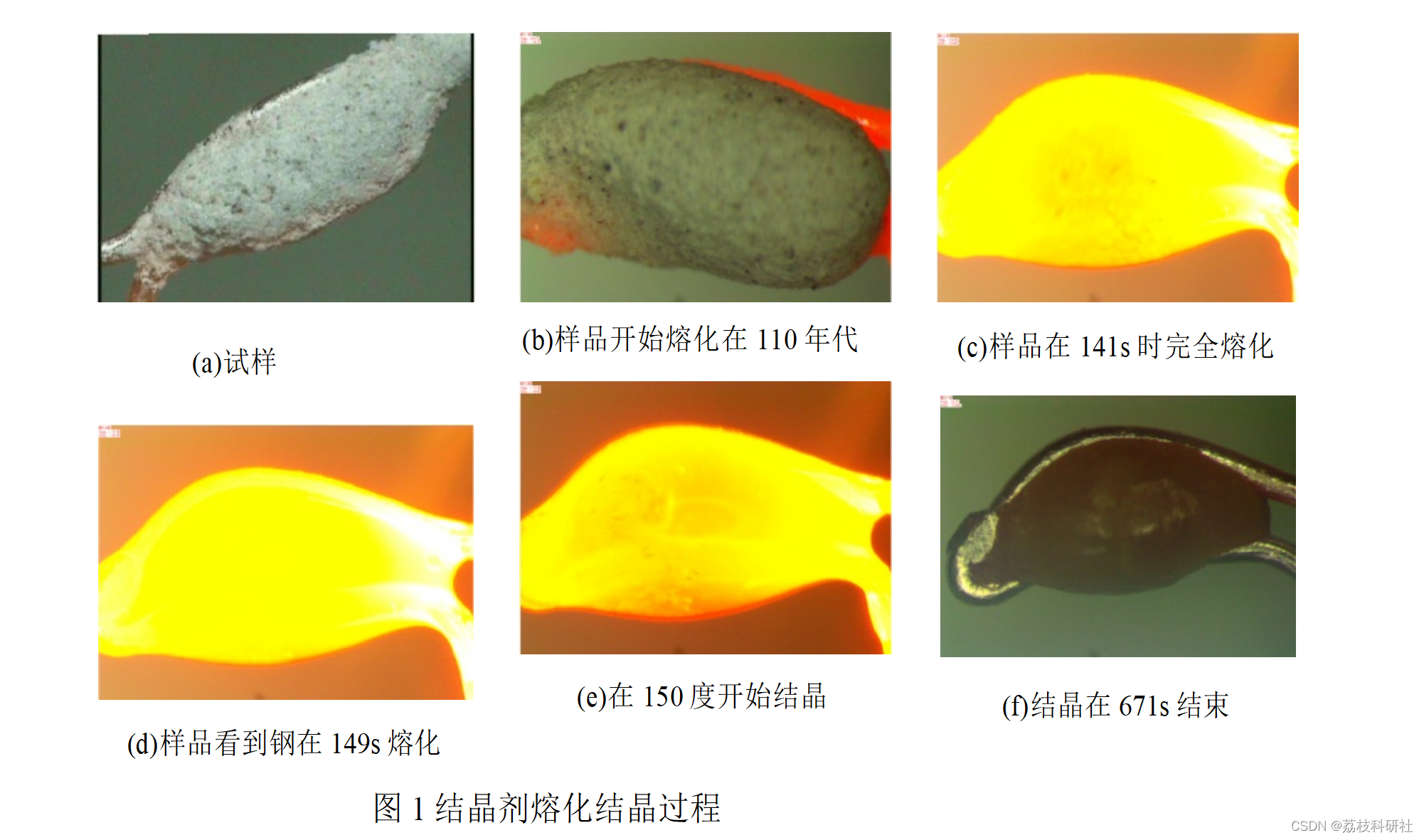👨🎓个人主页:研学社的博客
💥💥💞💞欢迎来到本博客❤️❤️💥💥
🏆博主优势:🌞🌞🌞博客内容尽量做到思维缜密,逻辑清晰,为了方便读者。
⛳️座右铭:行百里者,半于九十。
📋📋📋本文目录如下:🎁🎁🎁
目录
💥1 英文题目及数据
📚2 中文翻译题目参考
2.1 题目
2.2 题目
🎉3 思路、程序参考......
🌈 4 参考文献

💥1 英文题目及数据
Problem A
Feature Extraction of Sequence Images and Modeling Analysis of
Mold Flux Melting and Crystallization
Mold fluxes in continuous casting process thermally insulate the molten steel meniscus,
prevent reoxidation of liquid steel during continuous casting of liquid steels, control heat
transfer, provide lubrication of strand, and absorb nonmetallic inclusions. Metallurgical
functions of mold flux is mainly determined by its melting rate and crystallization rate under
the temperature control curve. It is therefore important to study the phase distribution of mold
fluxes in the gap between mold wall and strand shell.
Continuous casting mold fluxes are added to the top of liquid steel in the mold. These solid
slags, accumulating on the surface of liquid steel as a powder layer, can prevent liquid steel
level crusting due to excessive temperature drop of liquid steel. The temperature of mold fluxes
then gradually rise to the melting point, and mold fluxes are melted to form a sintered layer.
Raw materials of mold fluxes form low-melting-point substances and then liquid slag through
chemical reactions, and the composition of mold fluxes will change to a certain extent.
It is
melting process
.
As mold fluxes are completely fused, a liquid slag layer will be formed and covering on
the surface of liquid steel. The slag film will be formed when the liquid slag infiltrates from the
slag pool at the steel liquid surface into the gap between the shell and the copper mold wall.
The slag against the strand still maintains liquid phase, because of the high temperature of the
strand surface. However, as the temperature of liquid slag decreases with that of the strand
surface in the longitudinal direction of the mold, the slag film, against the copper mold wall, is
quenched and solidified to form a glassy solid slag film (solidification behavior of slag film),
with mold’s forced cooling, while slag film will crystallize at certain areas and form a
crystalline layer (crystallization behavior of slag film) under suitable conditions, finally
creating a typical three-layer slag film structure: glassy layer, crystalline layer and liquid slag
layer.
This process is crystallization.
Because of the high temperature, transient fluid flow, complex phase transitions and
chemical reactions as well as the opacity of mold wall, it is difficult to observe the phase
changes of mold fluxes directly. The SHTT II tester of melting and crystallization temperature
2022 Asia and Pacific Mathematical Contest in Modeling
2
is now widely applied to observe the crystallization behaviors of mold fluxes. After the
experiment is finished, experimenters demonstrate the images one by one, record the
information in the upper left corner of the images, and identify the key node images with naked
eyes and experience (see Figure 1), so as to guide the design of mold fluxes to meet the
solidification requirements of steel grades. This process wastes manpower and hinders the
development of experimental process information. It is urgent to develop automatic feature
extraction and mathematical modeling technology of sequence images.
Attachment 1 has 562 sequence images of mold fluxes’ melting and crystallization. These
sequence images are collected from the 110th to 671st seconds when the experiment starts. The
file serial numbers follow the collection time sequence, and images are collected every 1s. The
information is presented by digital images in Attachment 1 (see Figure 1). The upper left corner
of each image is marked with the corresponding time of the image and the temperature values
of No.1 thermocouple and No.2 thermocouple.
百度网盘分享:
链接:https://pan.baidu.com/s/1nrCwpHhOn9WhRd1r5Hiu3Q
提取码:dnzo
--来自百度网盘超级会员V3的分享
📚2 中文翻译题目参考
2.1 题目
序列图像的特征提取与建模分析结晶器助熔剂熔炼与结晶
连铸过程中的结晶剂对钢液半月板进行隔热,防止钢液连铸过程中钢液的再氧化,控制传热,对钢坯提供润滑,吸收非金属夹杂物。结晶剂的冶金功能主要由其在温度控制曲线下的熔化速率和结晶速率决定。因此,研究结晶器助熔剂在结晶器壁与坯壳间隙中的相分布非常重要。
在模具的顶部加入连铸模具通剂。这些固体矿渣以粉末层的形式堆积在液态钢的 表面,可以防止由于液态钢的温度下降过高而导致的液态钢水平结皮。模具通量的温 度随后逐渐上升到熔点,模具通量被熔化形成烧结层。模具通量的原料通过化学反应 形成低熔点物质,然后形成液渣,模具通量的组成会发生一定程度的变化。这是熔化过程。
由于模具焊剂完全熔合,将形成液渣层并覆盖在液态钢表面。当液渣从钢液表面的渣池渗入壳体与铜模壁的间隙时,形成渣膜。由于链表面的高温,对链的矿渣仍然保持液相。但随着液渣的温度随模具纵向表面的降低,渣膜相对于铜模壁,淬火固化形成玻璃态固体渣膜(渣膜的固化行为),模具强制冷却,渣膜在一定区域结晶形成结晶层(渣膜结晶行为),最终形成典型的三层渣膜结构:玻璃层、结晶层、液渣层 。这个过程是结晶。
由于高温、瞬态流体流动、复杂的相变和化学反应以及模具壁的不透明度,很难直接观察模具通量的相位变化。SHTTII的熔化和结晶温度测试仪目前已广泛应用于观察模具通量的结晶行为。实验结束后,实验人员逐一对图像进行演示,记录在图像左上角,用肉眼和经验识别关键节点图像(见图1),指导模具通量设计,满足钢级的凝固要求。这一过程浪费了人力,阻碍了实验过程信息的开发。发展序列图像的自动特征提取和数学建模技术是当务之急。
附件1有562张结晶型助熔剂熔化结晶的序列图像。这些序列图像是从实验开始的第110秒到第671秒之间收集的。文件序列号遵循米集时间序列,母1杪不果一饮队图像NBa1以附件1中的数字图像形式呈现(见图1),每张图像的左上角都标注了图像对应的时间以及1号热电偶和2号热电偶的温度值。
为了实现模通量熔融和结晶序列图像的自动特征提取和数学建模,请回答以下三 个问题。
2.2 题目
问题1:利用图像分割和识别或其他技术,请自动提取每张图像左上角的1号热电偶和2号热电偶的温度,并自动导入到对应的表中附件2(请写出分步技术操作文档),并请制作温度-时间曲线图(1#导线温度-2#导线温度-时间曲线图;1#线平均温度-2#线平均温度-时间曲线图)。此外,1#线或⒉#线的测试结果不准确。请指出并解释。
问题⒉请根据图1中的6个节点图像,应用数字图像处理技术,研究和量化相邻序列图像在结晶、熔炼过程中的动态差异。在此基础上,请对量化后的不同特征进行时间序列建模,并根据数学模型的仿真结果,讨论结晶型熔剂的熔化结晶过程曲线。
问题3:给定温度和时间的变化,以及问题2的研究成果,请制作数学模型,讨论温度和时间的变化以及结晶剂的熔化结晶过程的函数关系,并根据数值模拟结果讨论结晶剂熔化结晶的动力学(温度、熔化速率和结晶速率的关系)。
以上全部翻译分享文档:
链接:https://pan.baidu.com/s/1TU4qIPR7oVGf_z2dprDrjA
提取码:ljz4
--来自百度网盘超级会员V3的分享
🎉4 思路、程序参考......
2022亚太数学杯数学建模竞赛A题
🌈 4 参考文献


